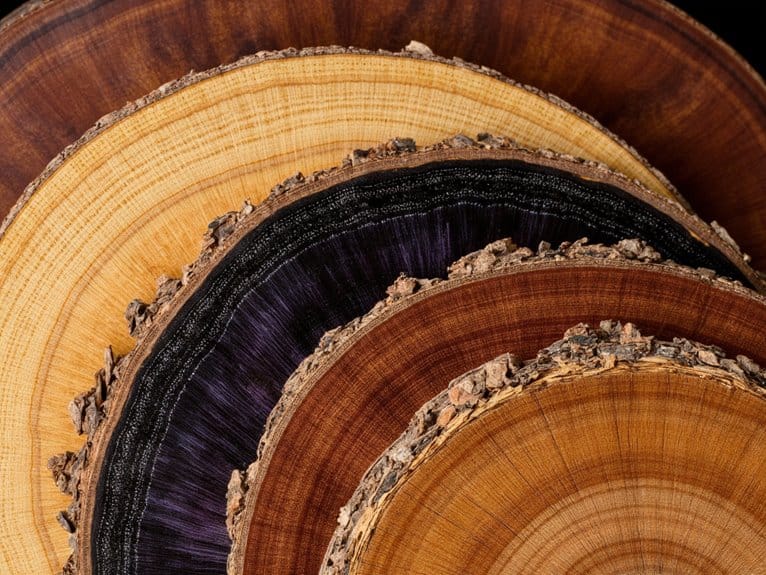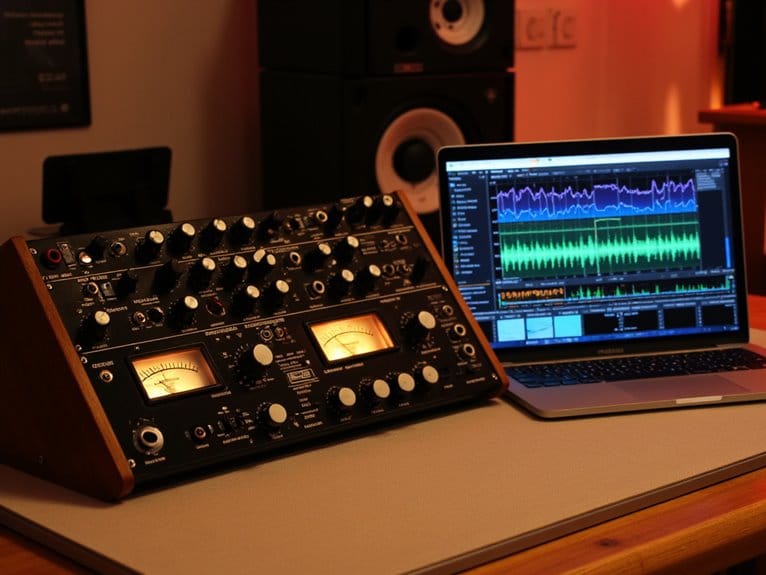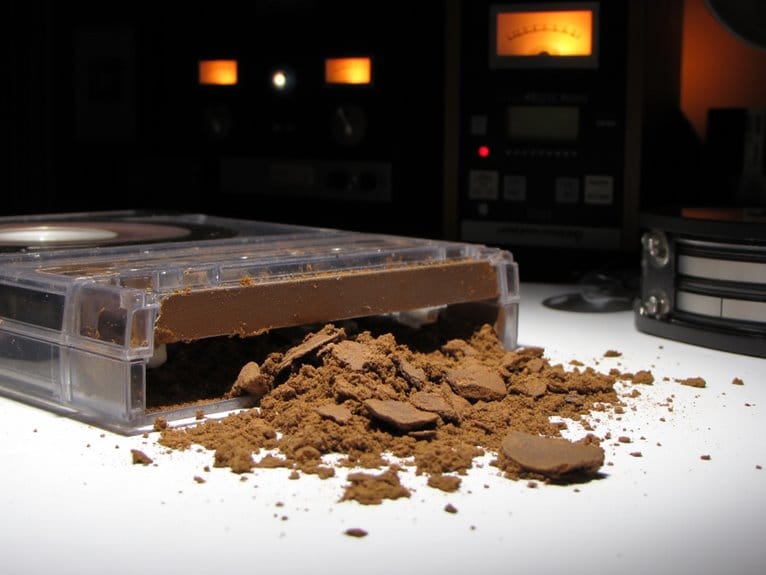Guitar Wood Types and How They Affect Tone
Your guitar’s wood selection fundamentally shapes its tonal character through density and stiffness properties that affect energy transfer. Dense woods like maple deliver bright sustain and articulation, while mahogany offers warm midrange punch with reduced brightness. Acoustic guitars benefit from spruce soundboards for projection and rosewood backs for bass response, whereas electric guitars utilize maple necks for stability and alder bodies for balanced frequencies. Understanding these wood combinations helps you match tonal qualities to your specific playing style and musical preferences.
We are supported by our audience. When you purchase through links on our site, we may earn an affiliate commission, at no extra cost for you. Learn more.
Notable Insights
- Wood density and stiffness affect energy transfer efficiency, with denser woods like ebony reducing energy loss compared to lighter woods like mahogany.
- Mahogany delivers bright treble and punchy midrange, while Indian rosewood provides strong bass and shimmering highs for enhanced tonal balance.
- Maple necks offer exceptional stability and bright sustain, while alder provides balanced midrange punch for electric guitar construction.
- Cedar tops suit fingerstyle playing with warmth and sensitivity, while spruce tops handle aggressive strumming with balanced attack and projection.
- Alternative tonewoods like sapele and koa provide unique characteristics, with koa offering versatile warmth and brightness across multiple musical genres.
The Science Behind Wood Density and Sustain
When I first started examining how wood affects guitar tone, I honestly didn’t expect the relationship between density and sustain to be quite so complex, but the physics behind it reveals fascinating insights that’ll change how you think about your instrument.
Wood density directly impacts sustain mechanics by controlling how efficiently your guitar transfers string vibrations, with denser woods like ebony reducing energy loss compared to lighter alternatives like mahogany.
However, it’s not just about weight—the stiffness-to-weight ratio, or Young’s modulus, plays an equally significant role in determining how long your notes ring out. Heavy blocks at bridge and headstock can significantly enhance sustain performance, while rigidity in neck connections has been noted to improve how long notes naturally decay.
Additionally, grain orientation and internal structure influence vibration propagation, meaning that even woods with similar densities can produce dramatically different sustain characteristics depending on their cellular makeup. Sound projection improves with wood that vibrates at a consistent rate, which explains why certain tonewood selections have remained popular among luthiers for centuries.
Popular Acoustic Guitar Body Woods and Their Tonal Properties
The arsenal of acoustic guitar body woods reads like a global timber tour, with each species bringing its own distinct sonic personality that’ll fundamentally shape how your instrument responds to your playing style.
When examining mahogany variants, you’ll discover genuine mahogany delivers bright treble with punchy midrange, while African mahogany offers mellow warmth perfect for fingerpicking.
Indian rosewood provides rich complexity with strong bass and shimmering highs, making it a studio favorite when paired with spruce tops.
Maple produces articulate brightness with focused trebles, ideal for jazz applications. The high density of maple not only creates its characteristic bright sound but also contributes to exceptional sustain capabilities.
Hawaiian koa balances between mahogany and rosewood territories, offering rounded midrange projection. The Taylor 224ce-K DLX demonstrates koa’s premium qualities with its solid koa construction creating exceptionally warm, balanced tone characteristics.
In any thorough tonewood comparison, walnut emerges with koa-like brightness but stronger midrange presence, while exotic options like padauk deliver vibrant resonance for rhythmic playing. For beginners exploring tonewoods, the popular combination of spruce tops with mahogany or basswood bodies provides an excellent balance of clarity and warmth. Yamaha demonstrates this principle effectively with their FG800J NT model, which pairs a solid spruce top with nato and mahogany back and sides to enhance overall sound quality.
Understanding Acoustic Guitar Soundboard Wood Characteristics
Every soundboard tells its own story through the microscopic fibers that’ll determine whether your guitar whispers sweetly or roars with authority, making your choice of top wood arguably the most significant decision in your acoustic guitar’s sonic destiny.
Every guitar’s soul lives in its soundboard fibers, where wood choice becomes the defining moment of your instrument’s musical voice.
When I examine guitar wood characteristics, I’m looking at how stiffness and density work together—stiffer woods like Sitka spruce deliver bright, articulate projection, while softer cedar responds quickly with warm intimacy.
The physics behind soundboard resonance involves weight ratios that affect everything from volume to sustain, where quarter-sawn grain orientation becomes vital for consistency.
Honestly, understanding these relationships between wood structure and tonal output helps you match your playing style with the right acoustic personality. Different body woods create distinct tonal characteristics, with poplar body construction offering a balanced, neutral tone foundation that works well across various musical styles.
Solid top guitars generally provide better tone quality compared to laminates, where the material impact directly influences bass response and overall sonic character across different guitar body sizes. Solid wood tops like Sitka spruce enhance resonance and tonal clarity over laminate construction, making them the preferred choice for discerning musicians.
Electric Guitar Wood Selection for Necks and Bodies
When you’re selecting wood for your electric guitar’s construction, the neck and body materials dramatically shape both the instrument’s tonal character and playability. Maple necks stand out as the industry standard due to their exceptional stability, bright sustain, and resistance to environmental changes.
Your body wood choice equally impacts the guitar’s voice, whether you opt for alder’s balanced midrange punch that’s defined countless Fender classics, mahogany’s rich warmth and substantial weight, or other species that each bring distinct tonal signatures to your playing experience. Different body woods affect tonal characteristics significantly and are essential considerations for matching your personal playing styles.
I’ve found that understanding these fundamental wood characteristics helps you make informed decisions about which combinations will best serve your musical style, budget constraints, and long-term satisfaction with the instrument. All-mahogany construction, commonly found in acoustic guitars, provides exceptional warmth and balanced tones that enhance both projection and clarity across various playing styles.
Maple Neck Characteristics
Brightness, snap, and remarkable stability define maple’s reputation as one of the most popular neck woods in electric guitar construction.
I’ve found that understanding its characteristics helps explain why so many legendary instruments rely on this dense hardwood. With its 1450 Janka hardness rating, maple delivers exceptional tone projection through tight, percussive attack and strong upper-midrange frequencies that cut through any mix.
The wood’s density creates playability nuances you’ll notice immediately—glossy finishes can feel sticky during fast passages, while satin coatings provide smoother hand movement. Roasted maple variants offer enhanced humidity resistance, maintaining tuning stability better than standard options.
This hardwood’s closed grain accepts lacquer beautifully, and premium flame or birdseye patterns add visual appeal to high-end instruments. Many beginner kits feature Canadian maple necks paired with rosewood fingerboards, providing new players with the same quality materials found in professional instruments. The C-shaped neck design commonly used with maple construction helps minimize hand fatigue during extended playing sessions. Advanced X-bracing patterns in acoustic guitars often complement maple neck construction to enhance overall structural integrity and tonal projection.
Body Wood Options
While maple necks provide the structural foundation for most electric guitars, the body wood you choose fundamentally shapes your instrument’s voice, sustain characteristics, and overall tonal personality in ways that’ll surprise even experienced players.
When comparing alder versus mahogany, you’re choosing between balanced clarity and thick warmth—alder delivers that spanky blues tone Fender’s built their reputation on, while mahogany gives you massive sustain with rich, deep frequencies that’ll make your chords ring forever. Quality materials like Canadian maple necks and mahogany bodies enhance sound quality without requiring premium pricing.
Ash sound characteristics lean bright and snappy with pronounced attack, particularly swamp ash variants that offer excellent sustain despite scooped mids.
Basswood and poplar provide affordable, balanced starting points, while exotic options like walnut or koa bring unique tonal complexities worth exploring.
For acoustic guitars, solid spruce tops deliver bright articulation and authentic resonance, while mahogany construction yields warmer tones that enhance overall tonal complexity and depth.
Visual Appeal and Grain Patterns Impact on Sound Quality
Although I’ve spent countless hours examining guitar tops in music stores, running my fingers across flame maple and admiring quilted patterns, I’ve learned that the relationship between a wood’s visual appeal and its actual sound quality isn’t as straightforward as many players assume. While grain aesthetics certainly drive market demand, with figured woods commanding premium prices, the tonal perception differences are often minimal and subjective.
| Grain Pattern | Visual Appeal | Tonal Impact |
|---|---|---|
| Straight | Clean, uniform | Balanced, predictable |
| Figured/Flame | Striking, wavy | Subtle complexity |
| Birdseye/Quilted | Intricate, decorative | Minimal difference |
Your visual preference shouldn’t overshadow practical considerations, since wood species and construction methods influence tone far more than grain patterns, despite what premium pricing might suggest.
Exploring Lesser-Known Tonewoods and Their Unique Qualities
You’ll discover that stepping beyond conventional mahogany and rosewood opens up fascinating sonic territories, where lesser-known tonewoods offer distinct characteristics that can transform your guitar’s voice in unexpected ways.
While sapele delivers a muscular midrange punch that sits between mahogany’s warmth and maple’s brightness, sycamore takes the opposite approach with its gentle, understated presence that won’t overpower delicate fingerpicking passages.
These alternative woods, including walnut with its evolving tonal personality that develops complexity over time, prove that sometimes the most interesting sounds come from materials that don’t get the spotlight in guitar shop conversations.
Sapele’s Powerful Midrange Character
Among the African tonewoods gaining recognition in modern guitar construction, Sapele stands out as a compelling alternative to traditional mahogany, delivering what I’d describe as mahogany’s muscular cousin with a brighter disposition.
The Sapele benefits include enhanced clarity and cutting power, while maintaining the woody warmth that makes mahogany so beloved.
What sets Sapele’s midrange response apart from its African cousin becomes evident through three key characteristics:
- Growling power – That rumbling intensity reminiscent of overdriven amplifiers
- HD clarity – More articulation and definition than standard mahogany
- Balanced brightness – Added treble shimmer without sacrificing midrange punch
I’ve found that Sapele’s denser grain structure creates harmonic complexity between low-mids and bass frequencies, making it particularly effective for players who need that midrange cut without losing fundamental warmth.
Sycamore’s Subdued Tonal Properties
While Sapele brings that muscular midrange presence to the table, sycamore takes us in a completely different direction, offering what I’d call the diplomatic tonewood of the guitar world. This lightweight wood possesses high dampening qualities that absorb sound energy, creating a particularly subdued, balanced character that won’t overwhelm your mix. When examining sycamore versatility, you’ll find it excels at controlled resonance rather than aggressive projection.
| Characteristic | Sycamore | Dense Tonewoods |
|---|---|---|
| Weight | Lightweight | Heavy |
| Brightness | Rolled-off highs | Crisp highs |
| Bass Response | Subdued lows | Pronounced bass |
| Sustain | Controlled | Extended |
| Tonal Character | Neutral/mellow | Distinctive |
For tonal comparison purposes, sycamore resembles commercial-grade agathis more than premium rosewood, though its aesthetic appeal and workability keep it relevant in modern construction.
Walnut’s Evolving Sound Profile
Black walnut occupies a fascinating middle ground in the tonewood spectrum, delivering what I’d describe as a chameleon-like character that shifts between familiar territories without fully committing to either extreme.
You’ll notice walnut tonal evolution developing over time, with initial woody bass deepening into richer foundations while the pronounced midrange bridges mahogany’s warmth with rosewood’s complexity.
What makes walnut particularly compelling includes:
- Balanced brightness – offering crisp highs without maple’s aggressive bell-like character
- Adaptive response – excelling equally in fingerstyle intimacy and flatpicking aggression
- Visual versatility – ranging from subtle grain to dramatic flamed figures
Beyond walnut aesthetic appeal, you’re getting density similar to koa with softer resonance that creates focused projection.
I’ve found walnut guitars reward extended playing, gradually revealing their full tonal complexity. This chambered body construction approach, similar to what you’ll find in some intermediate instruments, offers enhanced resonance and unique tonal depth that complements walnut’s natural characteristics.
While walnut remains less common than traditional choices like mahogany and maple, these quality materials contribute significantly to sound purity and overall tonal characteristics that enhance both amateur and professional performance applications. Many bass guitars feature maple necks paired with walnut bodies to create instruments that excel across diverse musical genres.
Choosing the Right Wood Combination for Your Playing Style
How do you match the perfect wood combination to your unique playing style when there’s such a dizzying array of tonewoods available?
Choosing wood becomes straightforward once you understand your playing style preferences and desired tonal balance.
If you’re a fingerstyle player seeking guitar warmth, cedar tops paired with rosewood back and sides deliver touch-sensitive responsiveness with rich harmonic complexity.
For aggressive strummers who need punchy midrange presence, spruce tops with mahogany backs provide the balanced attack you’re after.
Jazz players often gravitate toward all-mahogany guitars for their clarity and controlled brightness, while lead guitarists benefit from maple’s focused articulation.
Koa offers middle ground, bridging warmth and brightness for versatile players who want enhanced sustain without sacrificing tonal balance across frequencies.
Frequently Asked Questions
How Does Humidity and Climate Affect Different Guitar Woods Over Time?
Humidity fluctuations cause your guitar woods to expand and contract differently over time. Climate conditions affect each species uniquely – cedar and redwood expand less than spruce, while mahogany shows excellent stability in varying environments.
How Much Does Wood Thickness Affect Tone Compared to Wood Type Selection?
You’ll find wood density determines your guitar’s fundamental resonance qualities, while thickness fine-tunes responsiveness and volume. Wood type sets the tonal foundation first, then thickness adjustments optimize how those inherent characteristics express themselves.
Are Expensive Exotic Woods Worth the Cost for Beginner and Intermediate Players?
You won’t notice significant tonal benefits from expensive exotic woods as a beginner or intermediate player. The price comparison doesn’t justify the cost since you’re still developing your ear and technique fundamentals.
On a final note
You’ll find that understanding wood’s impact on your guitar’s tone isn’t just about following trends—it’s about matching the instrument’s voice to your musical expression. Whether you’re drawn to the warm resonance of mahogany, the bright clarity of maple, or the balanced complexity of rosewood, your wood choices directly shape how your playing translates into sound. Trust your ears, experiment when possible, and remember that the best tonewood is the one that inspires you to play.







